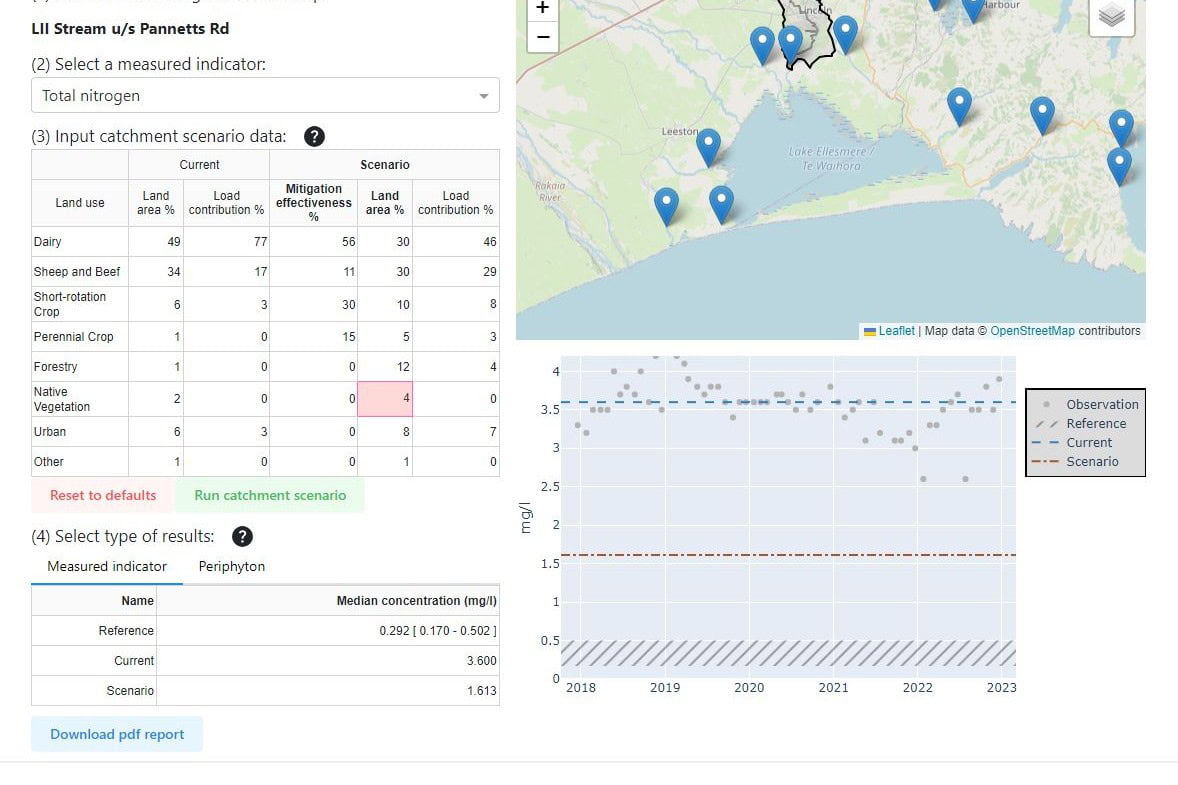August 30, 2024
-
- About UsMā mātou
- Our ScienceTe pūtaiao
- Future Landscapes Ngā Horanuku AnamataIn the future, landscapes will contain mosaics of land use that are more resilient, healthy and prosperous than today.
- Assessing Contaminants with Stream Order
- Benign Denitrification in Groundwaters
- Cascade of Soil Erosion
- Connecting Soil and Water Quality
- Crop Disease Under Climate Change
- Faecal Source Tracking
- Healthy Estuaries
- Innovative Agricultural Microbiomes
- Interoperable Modelling
- Land Use for Nutritious Diets
- Land Use Opportunities
- Land Use Suitability
- Linking Legacies to Wai
- Mapping Freshwater Contaminants
- Matarau: Empowering Māori Landowners in Land Use Decisions
- Measuring Denitrification
- Monitoring Freshwater Improvement Actions
- Mosaic vs Monoculture Landscapes
- Next Generation Systems
- Pasture for Humans
- Peri-Urban Potential
- Phosphorus Best Practice
- Physiographic Environments of New Zealand
- Pohewa Pae Tawhiti
- Protein Future Scenarios
- Silvopastoral Systems
- Sources and Flows
- Visualising Forestry Harvesting Cycles
- Incentives for Change Ngā Poapoa PanoniWe want to reward New Zealand’s primary producers for producing high-value products in sustainable ways.
- Aotearoa Food Cultures
- Appropriate Use of Taonga Species
- Credence Attributes On Farm
- Early Māori Agricultural Entrepreneurship
- EU Green Deal: Impact on NZ Exports
- Eutrophication Product Footprinting
- Impact of Imported Feed Shortages
- Incentives for Data Sharing
- Indicators Working Group
- Integrating Value Chains
- Kaitiaki Intelligence Platforms
- Kuaha Matihiko: Digital Gateway
- Measuring Full Impacts of Land-Use Change
- New Models of Collective Responsibility
- Options for Rural Investment
- Reasons for Water Quality Improvement
- Regenerative Agriculture
- Register of Land Management Actions
- Rewarding Sustainable Practices
- Signals for Land Stewards
- The Matrix of Drivers
- Workforce Implications of Land-Use Change
- Pathways to Transition Ngā Ara WhakawhitiWe are growing understanding of what it takes to transition to resilient, healthy and prosperous futures, and are developing tools to help.
- Connecting Food Producers & Consumers
- Diverse Experiences of Farming
- Enhancing Assurance Schemes
- Future Scenarios for Arable Agriculture
- Implementing Te Mana o Te Wai
- Land-Use Scenarios for Nikau Farm
- Lessons from Our Land and Water
- Mauri Whenua Ora
- Ngā Tai-o-Rongo
- Predicting Agricultural Research Adoption
- Retiring Farmland into Ngahere
- Revitalise Te Taiao
- Rural Professionals Fund 2020–21
- Rural Professionals Fund 2021–22
- Rural Professionals Fund 2022–23
- Rural Professionals Fund 2023–24
- Science in Freshwater Policy Development
- Shared Vision for Land Use in Marlborough
- Storying Kaitiakitanga
- Synthesis Scenarios for Future Land Use
- The Collaboration Lab
- Trust and Social Licence
- Urban-Rural Partnerships for Equal Change
- Whenua Life Values
- Future Landscapes Ngā Horanuku AnamataIn the future, landscapes will contain mosaics of land use that are more resilient, healthy and prosperous than today.
- News + EventsHe pānui
- Resources Ngā rauemi
- View by topic
- Climate Change
- Collaboration
- E.coli
- Farm Environment Plans
- Farm Management
- Farming for Good
- Increasing Value
- Irrigation
- Land-Use Change
- Measuring Water Quality
- Mitigation
- Nitrogen
- NPS-FM
- Nutrient Management
- Phosphorus
- Regenerative Agriculture
- Sector Transformation
- Sediment
- Social Licence
- Te Ao Māori
- Te Mana o Te Wai
- Winter Grazing
- View by topic
- Outcomes Ngā puawaitanga
Resources for
Regional Authorities
Paul Sutherland
You are here: Home Roles Regional Authority
People in local government can help farms operate in ways that ensure the health of our land and water. Our resources can help you increase your local community’s understanding of the drivers for regulation, undertake effective collaboration, and improve decision-making in catchments.
Showing 1 - 12 of 234 results
Technical Report
Community Perceptions of Collaborative Freshwater Planning: A survey in three NZ regions
Regional councils are trialling collaborative planning as a means of addressing New Zealand’s complex challenges in freshwater management. Collaborative freshwater planning processes are now underway…
Journal Article
Municipal composts reduce the transfer of Cd from soil to vegetables
Cadmium (Cd) is a non-essential trace element that accumulates in agricultural soils through the application of Cd-rich phosphate fertiliser. Vegetables can accumulate Cd to concentrations…
Journal Article
The effect of soil moisture extremes on the pathways and forms of phosphorus lost in runoff from two contrasting soil types
Soil moisture and Olsen P concentrations play an important role in phosphorus (P) losses in runoff. Our hypotheses were as follows: (1) rainfall applied to…
Journal Article
Estimation of nutrient loads from monthly water quality data
Causes of variation between loads estimated using alternative calculation methods and their repeatability were investigated using 20 years of daily flow and monthly concentration samples…
Journal Article
A copula-based analysis of severity-duration-frequency of droughts in six climatic regions of NZ
We used a copula to model the joint drought duration-severity distribution and frequency to generate SDF curves for six locations in different climatic regions (3…
Technical Report
The Collaboration Lab: The transformative role of collaboration in managing our land and water
The Collaboration Lab has four aims: three research aims and a capacity-building aim. The research aims are: to understand how collaborative practice contributes to multiple…
Technical Report
Predicting Land-Based Nitrogen loads and Attenuation in the Rangitikei River Catchment – the Implications for Land Use
Where both the intensity of land use in high N-attenuation areas was increased and the intensity of land use in low N-attenuation areas was decreased,…
Technical Report
Evolving Public Perceptions of Freshwater Management in Three New Zealand Regions
This study assesses public opinion of regional councils’ freshwater management in areas with and without collaborative planning processes. This study also assesses change in the…
Journal Article
Does variable rate irrigation decrease nutrient leaching losses from grazed dairy farming?
A six-year study was conducted to determine whether the use of variable rate irrigation (VRI), compared to uniform rate irrigation (URI), could decrease N and…
Journal Article
Assessing the Yield and Load of Contaminants with Stream Order: Would Policy Requiring Livestock to Be Fenced Out of High-Order Streams Decrease Catchment Contaminant Loads?
This paper won the JEQ Best Paper Award 2019. Concentration and flow data for 1998 to 2009 were used to calculate catchment load and yields…
Video
Powhiri: An indigenous example of collaboration from New Zealand
New Zealand co-conference to International Transdisciplinarity Conference, Germany.
Guidance
Six Criteria for Selecting Fit-for-Purpose Indicators
For OLW research, there are six criteria that are the most important for ensuring indicators are useful. Fit-for-purpose indicators are: accepted by stakeholders, valid, clearly…
 View Our Strategy Document 2019 – 2024
View Our Strategy Document 2019 – 2024


